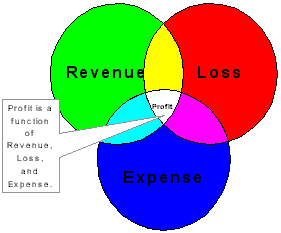
Business Solutions for Your Profitable Future
Revenue
cost reduction model - profit equation
Revenue is overlooked in Cost Reduction and Cost Cutting Initiatives. Revenue just isn't part of the cutting equation.
Cutting, cutting and more cutting not only reduce costs but they also undermine the enthusiasm and good will that are critical to growth. Some companies take decades to recover from cost cutting campaigns if they ever recover.
The Profit Improvement Process (PIP) is more effective because it focuses on loss and revenue in addition to expense. There is room for growth and a future with a Profit Improvement Program.
Examples of avenues for revenue growth include:
- Increased selling prices
- Reduced selling prices (volume growth/market share growth)
- Increased sales of existing products to existing customers
- New products to existing customers
- Retreat from sub-optimal businesses and/or customers
- Product line variations and extensions
- Bundled products and services
- New markets for existing products
- New products for existing markets
- New products for new markets
What PIP Does to Revenues:
The Profit Improvement Process (PIP) focuses on the profitability of sales. Key points about revenue management include:
- Revenue growth is a focal point of the process to keep the company vital and alive.
- Provides a forum for the fair evaluation of revenue opportunities.
- Recognizes that you usually cannot sell yourself out of bad businesses. You just can't make it up on volume when the contribution margin is negative.
- Puts management focus on what's right for the company. It is quite often easier to have your old ideas approved.
- Builds teamwork between the various factions in the company that might have stood in the way of progress.
- Helps educate people on what constitutes profitable business.
- Facilitates better business decisions.
